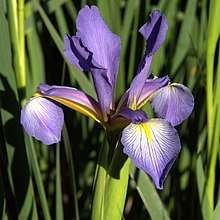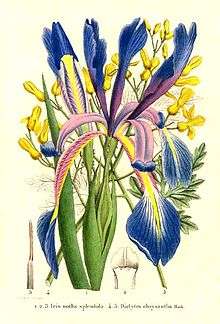Iris notha
Iris notha is a species in the genus Iris, it is also in the subgenus Limniris and series Spuriae. It is a rhizomatous perennial with deep blue or violet flowers from the Caucasus region. It is cultivated as an ornamental plant in temperate regions. It was once Iris spuria subsp. notha, and can often be found under that name. It has the common name of fake iris or mimic iris in Russia.
| Iris notha | |
|---|---|
 | |
| Scientific classification | |
| Kingdom: | Plantae |
| Clade: | Tracheophytes |
| Clade: | Angiosperms |
| Clade: | Monocots |
| Order: | Asparagales |
| Family: | Iridaceae |
| Genus: | Iris |
| Subgenus: | Iris subg. Limniris |
| Section: | Iris sect. Limniris |
| Series: | Iris ser. Spuriae |
| Species: | I. notha |
| Binomial name | |
| Iris notha | |
| Synonyms[1] | |
| |
Description
It has a stout, thick rhizome,[2][3] that is between 8–20 mm thick.[4][5] The roots are sometimes described as adventitious (in an unusual place).[3]
It has linear, smooth, acuminate (tapering to a long point) 65–95 cm (26–37 in) long and 6–18 mm wide leaves.[2][3][6] The leaves can be as long or longer than the peduncle.[4]
It has un-branched erect, stem, growing up to 30–90 cm (12–35 in) tall.[7][8][9]
It has dark green, linear, lanceolate, acuminate, spathes (leaves of the flower bud).[2][10]
It has unequal pedicels (stem of a single flower).[2]
The stems hold 3–5 terminal (top of stem) flowers,[3][7][11] between May and July.[2][6][12]
It has un-fragranced,[4] flowers that are up to 15 cm (6 in) in diameter,[2] that are violet-blue,[7][9][11] and bright blue.[6][8][9]
It has 2 pairs of petals, 3 large sepals (outer petals), known as the 'falls' and 3 inner, smaller petals (or tepals, known as the 'standards'.[13] The falls are deflexed, elliptic or ovate and narrowed at the claw (section near the stem).[2][3][6] It has a yellow central stripe (or blaze).[7][8][11] The standards are erect, oblong and narrowed at the stem.[2][6]
It has a 20mm long perianth tube.[2][3]
It has slightly recurved, style branches,[2] that are in the same shades of colour as the petals.
After the iris has flowered, it produces a seed capsule in August.[12] It is 6 angled, has a beak-like appendage,[2] and woolly-ribbed.[3]
Inside the capsule, are light brown, rugose (wrinkled), semi-circular and flattened seeds.[2][3][4]
Biochemistry
As most irises are diploid, having two sets of chromosomes. This can be used to identify hybrids and classification of groupings.[13] It has a chromosome count: 2n=38. It has been counted several times, 38 in 1969 by O.I. Zakharyeva and L.M. Makushenko, 44 in 1970 by AK Sharma and 42 in 1978 by V Karihaloo.[14]
Taxonomy

It has the common names of fake iris,[4][12][15] and mimic iris.[16]
The Latin specific epithet notha refers to the former name of the city of Ararat in Armenia.[2]
It was published as Iris notha by Friedrich August Marschall von Bieberstein in 'Flora Taurico Caucasica. Vol.3 page45 in 1819.[2][6]
It was the originally published and described by Bieberstein in 'Centuria Plantarum Rariorum Rossiae Meridionalis' (Cent. Pl. Ross. Merid.) Vol.3 page77 in 1843.[1]
It was also published by Boiss. in Flora Orientalis (Fl. Or.) Vol.5 page128 in 1884.[6]
It was then published as Iris spuria subsp. notha (M. Bieb.) Aschers. & Graebn. in Synops. Mitteleur Flora. Vol.3 page496 in 1905.[6][17] Then by B. Mathew in his book Iris page118 in 1981.[6]
It was then published as Iris notha by Köhlein in his book Iris page 169 in 1987.[6]
It was verified as Iris spuria subsp. notha (M.Bieb.) Asch. & Graebn. by United States Department of Agriculture Agricultural Research Service on 9 January 2003.[17]
Iris spuria subsp. notha is currently in February 2015, an accepted name by the RHS.[18]
Distribution and habitat
Conservation
This is a scarce species with a fragmented population.[16]
Since, 1986 it has been listed in the Red Data Book of the Russian Federation (the soviet version of the IUCN Red List), within several republics (such as Kalmykia, Krasnodar, Stavropol and the Azov region).[12][16] It is located in the ecological-recreational region of Kavkazskie Mineralnye Vody, which is under special protection.[16]
It is threatened due to the flowers being picked for bouquets and uncontrolled livestock grazing.[5]
Cultivation
It is hardy to H2.[8] It winters without shelter in various places within Russia.[15][20]
It was introduced to Britain in 1820.[11]
It was first grown in St. Petersburg Imperial Botanical Garden in 1841.[15]
It is cultivated in many botanical gardens of the USSR,[19] including, Moscow, Syktyvkar, Michurinsk, Samara, Stavropol, Nalchik, Dnepropetrovsk, Uzhgorod and St. Petersburg.[15][20]
It is suitable to be grown in parks in dry conditions.[20] It is tolerant of acid soils.[5]
References
- "Iris notha M.Bieb. is an accepted name". theplantlist.org (The Plant List). 23 March 2013. Retrieved 14 January 2015.
- Komarov, V.L. (1935). "Akademiya Nauk SSSR (FLORA of the U.S.S.R.) Vol. IV". Retrieved 9 October 2014.
- "Lat. Iris". agbina.com. Retrieved 17 February 2015.
- Bend, Samara (2007). "COLLECTION IRIS natural flora, Introdutciruemyh in the Botanical Garden Samara State University" (PDF). ssc.smr.ru (Samara State University). Retrieved 14 February 2015.
- "Iris spuria subsp. notha in the Red Data Book of the Chechen Republic". oopt.aari.ru. Retrieved 14 February 2015.
- "Pakistan V. 202". efloras.org (Flora of Pakistan). Retrieved 12 February 2015.
- Cassidy, George E.; Linnegar, Sidney (1987). Growing Irises (Revised ed.). Bromley: Christopher Helm. p. 141. ISBN 0-88192-089-4.
- Stuart Max Walters (editor)The European Garden Flora Flowering Plants: A Manual for the Identification (2011) , p. 348, at Google Books
- "Chapter II iris clump and other (part3)". irisbotanique.over-blog.com. Retrieved 17 February 2015.
- "Spuria iris". flowerlib.ru. Retrieved 12 February 2015.
- "Iris spuria L. subsp. notha (Bieb.) Asch. & Grabn". hortuscamden.com. Retrieved 14 February 2015.
- Shmaraeva, A.N.; Shishlova, J.N.; Fedyaeva, V.V. (December 2014). "Fake iris (Iris notha Bieb.) In the Azov district of Rostov region". Living and Biokosnye System. 8 (10). Retrieved 14 February 2015.
- Austin, Claire (2005). Irises: A Gardener's Encyclopedia. Timber Press, Incorporated. ISBN 978-0881927306. OL 8176432M.}
- "6 chromosome counts in Iris notha M. Bieb". ccdb.tau.ac.il. Retrieved 14 February 2015.
- "The exhibition "Iris Russia"". flower-iris.ru. Retrieved 14 February 2015.
- "Iris spuria ssp. notha". iucnredlist.org. Retrieved 14 February 2015.
- "Iris spuria subsp. notha". Germplasm Resources Information Network (GRIN). Agricultural Research Service (ARS), United States Department of Agriculture (USDA). Retrieved 14 February 2015.
- "Iris spuria subsp. notha". www.rhs.org.uk. Retrieved 14 February 2015.
- Rodionenko, G. I. "Iris (Iris) fake (Iris notha)". calc.ru. Retrieved 14 February 2015.
- "Iris (Iris) fake (Iris notha)". derevnyaonline.ru. Retrieved 17 February 2015.
Sources
- Czerepanov, S. K. 1995. Vascular plants of Russia and adjacent states (the former USSR). [= I. notha M. Bieb.].
- Komarov, V. L. et al., eds. 1934–1964. Flora SSSR.
- Mathew, B. 1981. The Iris. 118.
- Nasir, E. & S. I. Ali, eds. 1970–. Flora of [West] Pakistan.
- Tutin, T. G. et al., eds. 1964–1980. Flora europaea. [mentions].